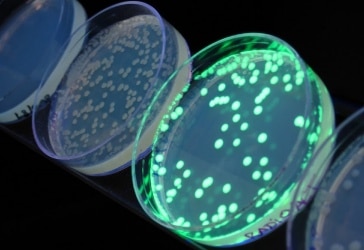If you have ever attempted to load a SDS-PAGE gel only to miss the well, stab the divider, and then watch helplessly as your sample squirts off into the wrong well, then this tip is for you.
The fortunate among us are able to use pre-cast gels with the wells outlined on the gel plate, but home-made gels don’t have this feature. I’ve seen labs with various loading guides printed off on acetate that they stick to the front plate of the gel before loading, which is better than nothing, but only shows you where the well is supposed to be, not where it is. It is true that after loading enough gels you start to develop an eye for finding the wells, but there is an easier way.
The trick is as simple as this: add a bit of bromophenol blue to your stacking gel. If you remember, bromophenol blue is already in your loading dye, so you aren’t adding anything new to the SDS-PAGE equation. I find that adding the dye to 0.003% is enough to color the stacker, but you can adjust the concentration to your liking. To make things even easier, I simply add the dye to my 4X Stacking Gel Buffer (0.5M Tris-HCl pH 6.8, in my case) to a final concentration of 0.012%. Now you don’t even have to add a new line to your recipe. You can see the results below.




As you can see, the wells are easy to visualize. Once the voltage is applied, all the dye in the gel collapses down into the dye front and the gel runs normally. If the color of the stacking gel is too similar to the color of your protein samples, then you can simply add more bromophenol blue to your concentrated loading buffer (you’ll find that recipes vary on this point anyway). For the sake of the photographs, I ran this gel without the cover – this is potentially dangerous, so don’t try this at home…urr… I mean, your lab.






